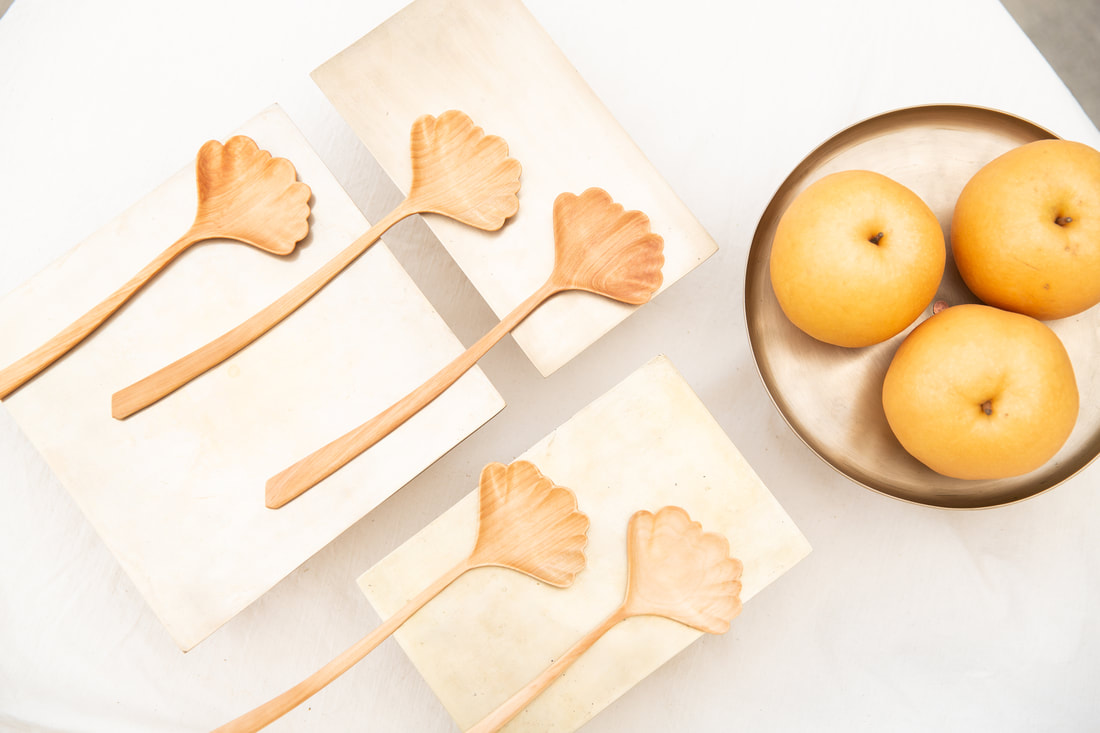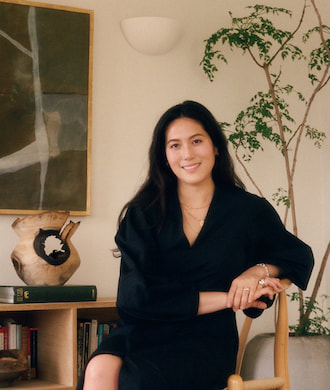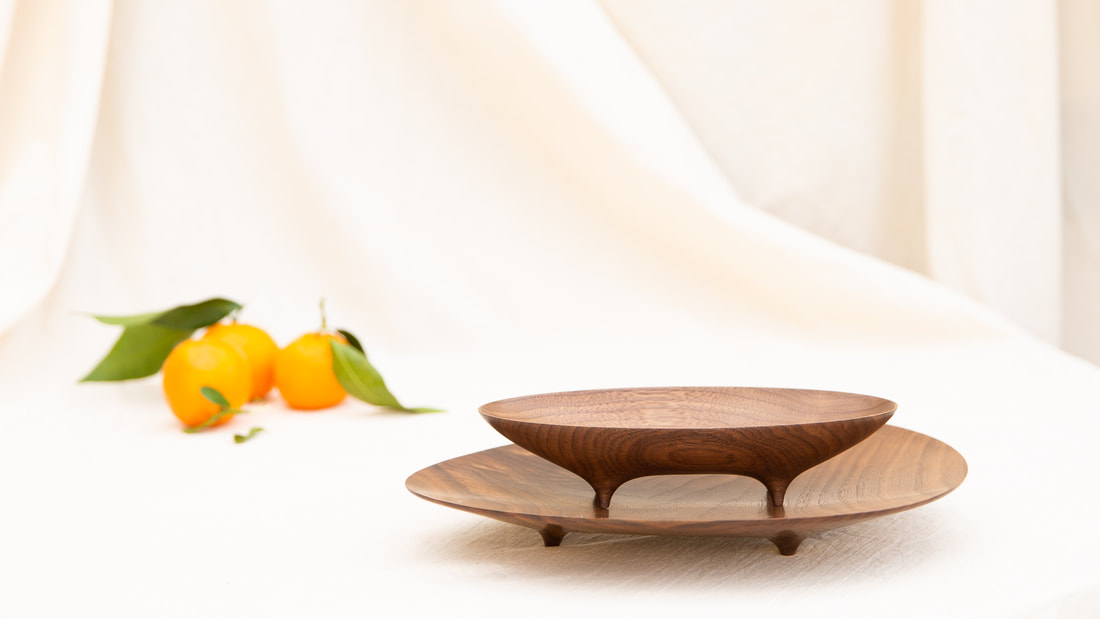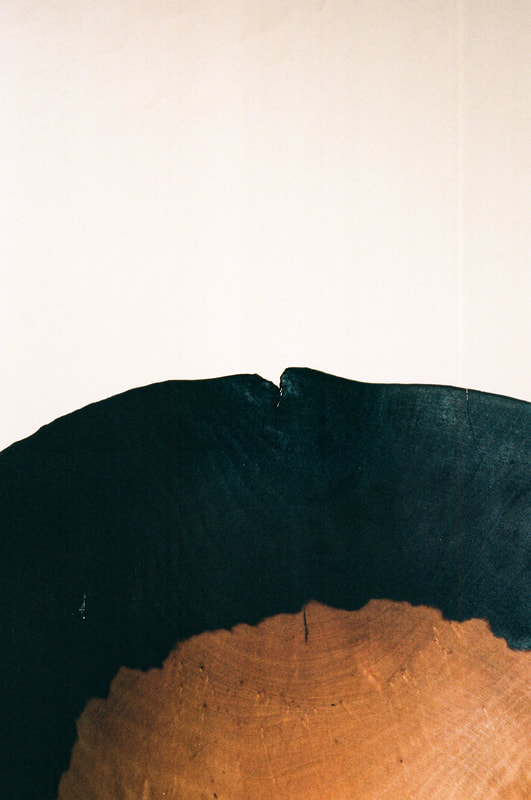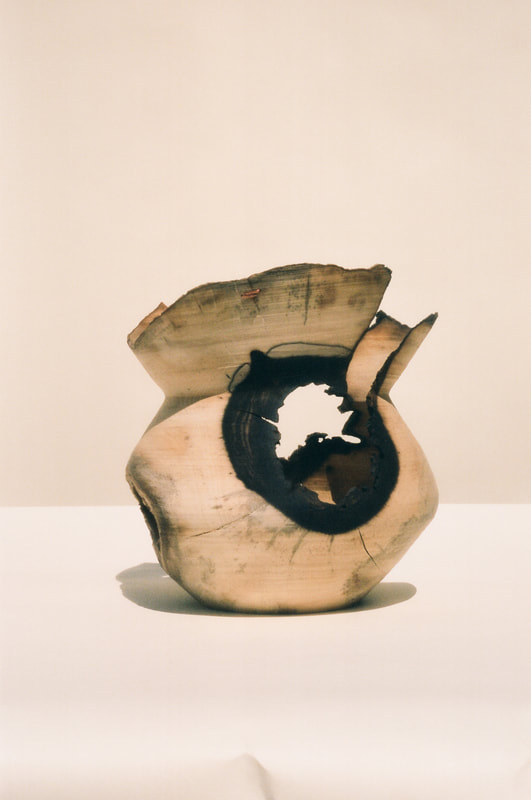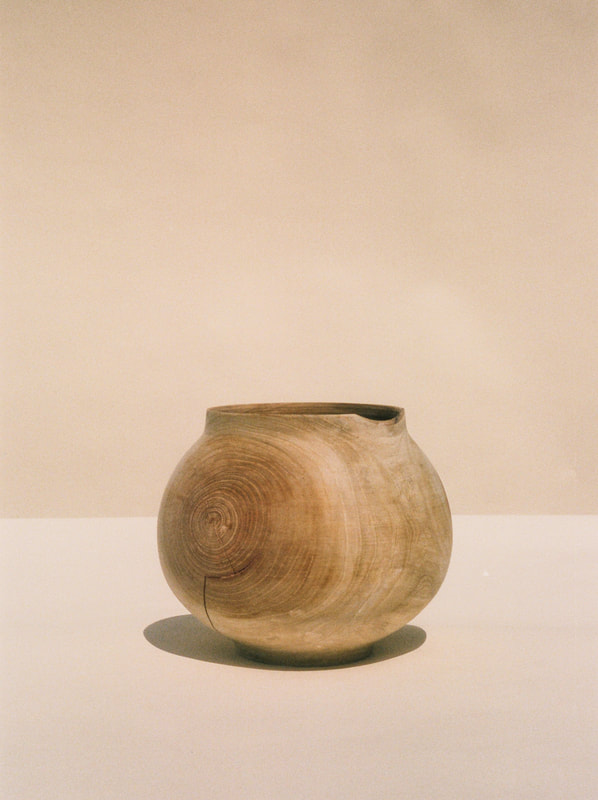Diana Ryu on Starting a Business During a Pandemic, Honouring the Imperfect Gifts of Trees, and Highlighting the Stories of Korean Artistry
Interview by Harriet Kim & Mirae Lee
Heritage woodwork may not be an obvious topic when exploring jip-bab. However, you might think of the ways we need to plate and serve the food we eat or the emotions that might be evoked by the ways we eat and gather (and, by extension, the ways we decorate our dining areas and homes). We felt connected to the mission of Namu Home Goods and how it is grounded in honouring the web of relationships we have with trees, in all their forms—going beyond any transaction of cutting a tree, making a functional item out of it, and selling it, with the assumption that the life of the tree ends there. The pieces in this collection are still living and breathing, even if they don’t take the shape of the original tree that they came from. Sometimes, the final woodwork takes on the likeness of familiar foods, like jujubes.
We spoke with Diana Ryu, founder of Namu Home Goods, about being inspired by and honouring the imperfect gifts of trees, highlighting the stories and traditions of Korean artistry, and starting a business (during a pandemic, no less!).
This interview was edited for grammar, flow, and clarity.
We spoke with Diana Ryu, founder of Namu Home Goods, about being inspired by and honouring the imperfect gifts of trees, highlighting the stories and traditions of Korean artistry, and starting a business (during a pandemic, no less!).
This interview was edited for grammar, flow, and clarity.
|
choa magazine (CM): Congratulations on launching Namu Home Goods. Can you tell us more about it and what an average day, or week, at Namu looks like behind the scenes?
Diana Ryu (DR): Thank you. It’s been a fulfilling few weeks. Namu Home Goods is a brand where I curate heritage woodwork to be passed down for generations. Everything I source is from Korea, where wood is treated as a precious medium. The level of artistry and refinement is very different from what we have in North America. It’s very much about celebrating imperfection and the organic shapes that nature has gifted us. The best part of starting my own business is that no day is the same. I talk to the artists at least once a week regarding inventory, do a lot of writing for the stories that accompany each art piece and artist, and work closely with editors and press. One day might be a full-day photoshoot; another might be a full day of packing orders. |
I curate with an artist’s eye for pieces that emote something intangible—art that takes your breath away. |
CM: Can you tell us about the ethos and values behind Namu and how you infuse that into your business?
DR: The ethos and values of Namu Home Goods are two-fold. Firstly, it’s to curate heritage woodwork to be passed down for generations. I curate with an artist’s eye for pieces that emote something intangible—art that takes your breath away. |
Secondly, the more important value is to take up space as an Asian body in America. Art and home décor in America are Eurocentric. It’s important for me to share the stories of these Korean artists while using my creativity. Asians are often seen as a monolith—analytical, methodical, and logic-driven. But, as with any group of people, we are also artistic, emotional, and imaginative. I needed to tell that story.
CM: You describe your business as featuring traditional Korean pieces with a distinct Korean-American aesthetic. Tell us about this and what it means for you to bring these two threads together. What does that look like in practice?
DR: My unique experience in the world is through my Korean-American lens, and I want to share that intersectionality with the collectors of Namu Home Goods. The pieces I source from Korea aren’t traditional, but they are made with a refinement that comes from traditional Korean arts—a focus on celebrating nature. For example, ott-chil is a lacquering practice using the sap of the ott-chil tree that functions as a natural preservative. Another practice that many woodworkers gravitate toward is dal-hangari shapes (moon jars normally made out of porcelain). The pieces are seasonless, timeless, and in good taste. No matter what your aesthetic, these artworks carry an idea or philosophy that can resonate with collectors around the globe.
At the high level, I’m marketing to a person who aligns with the values of Namu Home Goods, rather than specifically going after a Korean-American audience. I’m happy to share these Korean artists with the world. I have so much conviction that they should be recognized by everyone who interacts with Namu Home Goods, and I’m honored to open up a new audience for their work.
CM: You describe your business as featuring traditional Korean pieces with a distinct Korean-American aesthetic. Tell us about this and what it means for you to bring these two threads together. What does that look like in practice?
DR: My unique experience in the world is through my Korean-American lens, and I want to share that intersectionality with the collectors of Namu Home Goods. The pieces I source from Korea aren’t traditional, but they are made with a refinement that comes from traditional Korean arts—a focus on celebrating nature. For example, ott-chil is a lacquering practice using the sap of the ott-chil tree that functions as a natural preservative. Another practice that many woodworkers gravitate toward is dal-hangari shapes (moon jars normally made out of porcelain). The pieces are seasonless, timeless, and in good taste. No matter what your aesthetic, these artworks carry an idea or philosophy that can resonate with collectors around the globe.
At the high level, I’m marketing to a person who aligns with the values of Namu Home Goods, rather than specifically going after a Korean-American audience. I’m happy to share these Korean artists with the world. I have so much conviction that they should be recognized by everyone who interacts with Namu Home Goods, and I’m honored to open up a new audience for their work.
CM: After researching artists and deciding who might be a fit, what is the process of reaching out to them and developing those relationships? Can you tell us about your sourcing trip(s) to Korea?
DR: The artists I reached out to were, by and large, extraordinarily receptive. They could sense that I loved and respected trees as much as they did, especially because, at its core, Namu Home Goods is a vehicle to tell the story of their work. I went on my first sourcing trip right in the middle of Covid-19. Korea is strict about their safety and health measures (which is a testament to their low death rates), so I was required to complete a two-week quarantine in a government facility. It was difficult, but it was a small price to pay to create relationships with these wonderful artists. My husband and I spent four weeks driving around to meet these artists from every corner of the country. We saw more of Korea than we ever had before—it was a beautiful experience.
During this trip, I personally loved Jeonju, which is a heritage hanok village. If you focus on the architecture, you forget that it's touristy. But mostly, I liked meeting the artists in their spaces. We didn’t do that much vacationing or leisure travel—most of the movement was very deliberate.
DR: The artists I reached out to were, by and large, extraordinarily receptive. They could sense that I loved and respected trees as much as they did, especially because, at its core, Namu Home Goods is a vehicle to tell the story of their work. I went on my first sourcing trip right in the middle of Covid-19. Korea is strict about their safety and health measures (which is a testament to their low death rates), so I was required to complete a two-week quarantine in a government facility. It was difficult, but it was a small price to pay to create relationships with these wonderful artists. My husband and I spent four weeks driving around to meet these artists from every corner of the country. We saw more of Korea than we ever had before—it was a beautiful experience.
During this trip, I personally loved Jeonju, which is a heritage hanok village. If you focus on the architecture, you forget that it's touristy. But mostly, I liked meeting the artists in their spaces. We didn’t do that much vacationing or leisure travel—most of the movement was very deliberate.
The pieces I source from Korea aren’t traditional, but they are made with a refinement that comes from traditional Korean arts—a focus on celebrating nature. |
CM: What kind of relationships do these artists have with the landscape around them and the trees they work with?
DR: All of the artists I work with only use local Korean wood. Each artist has a different relationship with their surroundings: some artists have their studios in the densest parts of Seoul, some are in compounds in the countryside, and some are by the ocean. It depends, but they all have a deep love for—and find solace in—nature. |
Much of the wood Heum Namkung uses, for example, is from his hikes. He uses wood that has already fallen due to natural causes. Park Honggu doesn’t leave his compound in the countryside, but gets inspiration from the tiniest blade of grass to the dew drops on leaves. He doesn’t need to look far and wide, but instead gets really microscopic.
|
CM: Could you tell us a bit about the kinds of Korean trees they work with, and what makes them special?
DR: Korean trees are much thinner than trees in America (the land is just smaller), so wood is a precious medium. The artists have to be much more precise about their cuts, and nothing goes to waste. Korea experiences four distinct seasons. Bitter winters create trauma on the bark, leading to more interesting colours once you open up the log of wood. It also has wet and humid summers, which affects the wood and the overall drying process. It can take up to 15 years for a slab of wood to become usable, so it’s a lesson in patience and letting go of control. When you see all the discolouration, naturally occurring holes, cracks, and rings on Namu Home Goods pieces, those are due to the tree’s natural elements and environment. There are trees like the Paulownia tree, which artist Kim Gyu calls “the perfect wood.” It’s strong, but flexible, and it’s also the wood used for making the gayageum, a traditional Korean zither. CM: We were intentional about using the Korean word to name our volume’s theme, instead of the English translation. I think jip-bab touches on something universal, while also reflecting something specific about how we, as Koreans, eat and share home-cooked meals, including those of us in the diaspora. What are your thoughts on incorporating the Korean language into your branding? |
DR: There is so much subtext in Korean culture, especially when it comes to food. It likely comes from a history of scarcity, but the expression of love through nourishment is so clearly evident. For me, the idea to call the brand “Namu” was a simple choice. The brand is like me—both Korean and American. I wanted to highlight that.
Diana Ryu worked as an editor and writer for over a decade in beauty, fashion, and lifestyle, including for an office job at goop, until she realized there was a whitespace for the type of home decor she wanted: heritage woodwork to be passed down for generations.

